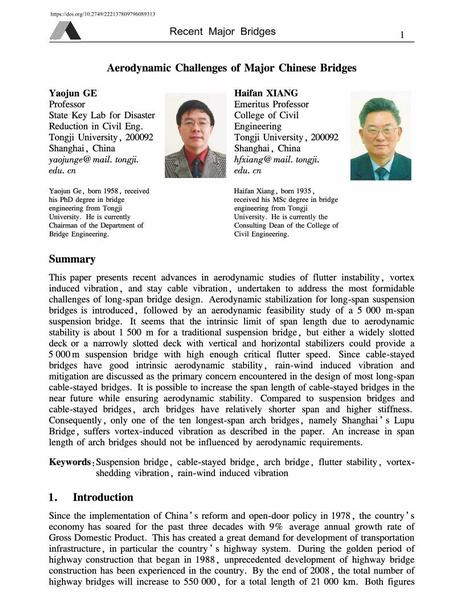Aerodynamic Challenges in Major Chinese Bridges

|
|
|||||||||||
Bibliographic Details
| Author(s): |
Yaojun Ge
Haifan Xiang |
||||
|---|---|---|---|---|---|
| Medium: | conference paper | ||||
| Language(s): | English | ||||
| Conference: | IABSE Workshop: Recent Major Bridges, Shanghai, China, 11-12 May 2009 | ||||
| Published in: | IABSE Workshop Shanghai 2009 | ||||
|
|||||
| Page(s): | 142-164 | ||||
| Total no. of pages: | 23 | ||||
| Year: | 2009 | ||||
| DOI: | 10.2749/222137809796089313 | ||||
| Abstract: |
This paper presents recent advances in aerodynamic studies of flutter instability, vortex induced vibration, and stay cable vibration, undertaken to address the most formidable challenges of long-span bridge design. Aerodynamic stabilization for long-span suspension bridges is introduced, followed by an aerodynamic feasibility study of a 5 000 m-span suspension bridge. It seems that the intrinsic limit of span length due to aerodynamic stability is about 1 500 m for a traditional suspension bridge, but either a widely slotted deck or a narrowly slotted deck with vertical and horizontal stabilizers could provide a 5 000 m suspension bridge with high enough critical flutter speed. Since cable-stayed bridges have good intrinsic aerodynamic stability, rain-wind induced vibration and mitigation are discussed as the primary concern encountered in the design of most long-span cable-stayed bridges. It is possible to increase the span length of cable-stayed bridges in the near future while ensuring aerodynamic stability. Compared to suspension bridges and cable-stayed bridges, arch bridges have relatively shorter span and higher stiffness. Consequently, only one of the ten longest-span arch bridges, namely Shanghai's Lupu Bridge, suffers vortex-induced vibration as described in the paper. An increase m span length of arch bridges should not be influenced by aerodynamic requirements. |
||||
| Keywords: |
cable-stayed bridge arch bridge suspension bridge flutter stability vortexshedding vibration rain-wind induced vibration
|
||||
